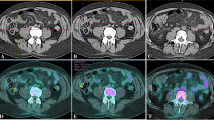Abstract
111In-granulocyte scintigraphy was performed on 245 patients in whom a localized infection was suspected. In 123 patients scintigraphy was positive and of these 35 (28%) had intestinal accumulations of 111In-granulocytes. Specific local causes for the intestinal uptake of radioactivity were antibiotic associated colitis (eight patients), local pyogenic bowel infection (four patients), systemic disease (two patients), bowel necrosis (two patients), colonic cancer (one patient) and Stevens-Johnson's syndrome (one patient). Nonspecific mechanisms of bowel accumulation were desquamation of labelled granulocytes (12 patients) and bleeding (two patients). In three cases the mechanism of colonic accumulation of granulocytes was not revealed. These results show that unexpected accumulations of labelled granulocytes in the gut is not a rare phenomenon and is often due to clinically significant intestinal inflammation or other disease, especially in patients who do not have signs of respiratory, pancreatic or oesophageal inflammation causing desquamated granulocytes to accumulate in the gut.
Similar content being viewed by others
References
Asbill MC, Shanahan F, Van Deventer GM (1985) Indium-111 leukocyte imaging in colitis induced by Clostridium difficile. J Nucl Med 26:315–316
Becker W, Schäffer R, Börner W (1985a) Sigmoid carcinoma mimicking an intra-abdominal abscess in an 111In-labeled white blood cell scan. Eur J Nucl Med 11:283–284
Becker W, Fischbach W, Börner W (1985b) Autologous 111In-oxine-labelled granulocytes in Yersinia infections. Eur J Nucl Med 10:377–378
Becker W, Fischbach W, Reiners C, Börner W (1986) Three-phase white blood cell scan: diagnostic validity in abdominal inflammatory disease. J Nucl Med 27:1109–1115
Bernstein RM, Mackworth-Young CG, Saverymuttu SH, Gupta S, England JPS, Hughes GRV (1984) Yersinia arthritis: demonstration of occult enteritis by 111Indium leucocyte scanning. Ann Rheum Dis 43:493–494
Fisher MF, Rudd TG (1983) In-111-labeled leukocyte imaging: false-positive study due to acute gastrointestinal bleeding. J Nucl Med 24:803–804
Goodwin DA (1983) Clinical use of In-111 leukocyte imaging. Clin Nucl Med 8:36–38
Gray HW, Cuthbert I, Richards JR (1981) Clinical imaging with indium-111 leukocytes: uptake in bowel infarction. J Nucl Med 22:701–702
Keshavarzian A, Price YE, Peters AM, Lavender JP, Wright NA, Hodgson HJF (1985) Specificity of indium-111 granulocyte scanning and fecal excretion measurement in inflammatory bowel disease — an autoradiographic study. Dig Dis Sci 30:1156–1160
Knochel JQ, Koehler PR, Lee TG, Welch DM (1980) Diagnosis of abdominal abscesses with computer tomography, ultrasound, and 111In leukocyte scans. Radiology 137:425–432
Saverymuttu SH, Peters AM, Hodgson HJ, Chadwick VS, Lavender JP (1982) Indium-111 autologous leucocyte scanning: comparison with radiology for imaging the colon in inflammatory bowel disease. Br Med J 285:255–257
Saverymuttu SH, Peters AM, Hodgson HJ, Chadwick VS (1983a) 111Indium leukocyte scanning in small-bowel Crohn's disease. Gastrointest Radiol 8:157–161
Saverymuttu SH, Peters AM, Lavender JP, Hodgson HJ, Chadwick VS (1983b) 111Indium autologous leucocytes in inflammatory bowel disease. Gut 24:293–299
Saverymuttu SH, Lavender JP, Hodgson HJF, Chadwick VS (1983c) Assessment of disease activity in inflammatory bowel disease: a new approach using 111In-granulocyte scanning. Br Med J 287:1751–1753
Saverymuttu SH, Phillips G, Peters AM, Lavender JP (1985a) Indium 111 autologous leucocyte scanning in lobar pneumonia and lung abscesses. Thorax 40:925–930
Saverymuttu SH, Peters AM, Crofton ME, Rees H, Lavender JP, Hodgson HJF, Chadwick VS (1985b) 111Indium autologous granulocytes in the detection of inflammatory bowel disease. Gut 26:955–960
Segal AW, Munro JM, Ensell J, Sarner M (1981) Indium-111 tagged leucocytes in the diagnosis of inflammatory bowel disease. Lancet ii:230–232
Sfakianakis GN, Al-Sheikh W, Heal A (1982) Comparison of scintigraphy with In-111 leukocytes and Ga-67 in the diagnosis of occult sepsis. J Nucl Med 23:618–626
Syrjälä MT (1985) Labelling of granulocytes with radioindium: Cell isolation and labelling parameters. Scand J Haematol 35:579–583
Syrjälä M, Remes K, Paavonen T, Liewendahl K (1985) Positive 111In-granulocyte scintigraphy in a patient with focal leukemic blast cell infiltrations. Eur J Nucl Med 10:557–559
Syrjälä MT, Valtonen V, Liewendahl K, Myllylä G (1987) Diagnostic significance of 111In-granulocyte scintigraphy in febrile patients. J Nucl Med 28:155–160
Wilson DG, Lieberman LM (1983) Gastrointestinal bleeding in leukocyte scintigraphy. Clin Nucl Med 8:214–215
Wing VW, van Sonnenberg E, Kipper S, Bieberstein MP (1984) Indium-111-labeled leukocyte localization in hematomas: a pitfall in abscess detection. Radiology 152:173–176
Author information
Authors and Affiliations
Rights and permissions
About this article
Cite this article
Syrjälä, M.T., Liewendahl, K., Valtonen, V. et al. Intestinal accumulation of 111In-granulocytes in patients studied because of occult infection. Eur J Nucl Med 13, 121–124 (1987). https://doi.org/10.1007/BF00289022
Received:
Issue Date:
DOI: https://doi.org/10.1007/BF00289022




